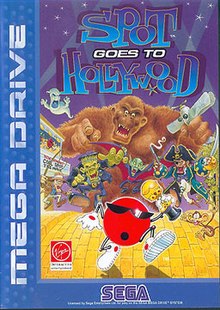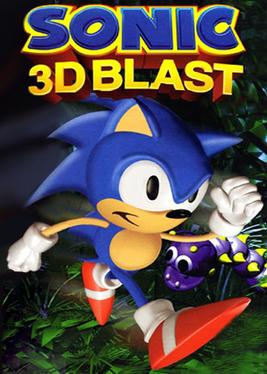
Sonic 3D Blast, known in Europe and Japan as Sonic 3D: Flickies' Island, is a 1996 platform game in the Sonic the Hedgehog series for the Sega Genesis and Sega Saturn. As Sonic the Hedgehog, the player embarks on a journey to save the Flickies, birds enslaved by Doctor Robotnik. The player must guide Sonic through a series of themed levels to collect Flickies and defeat Robotnik. Though it retains game mechanics from prior Sonic games, Sonic 3D Blast is differentiated by its 2D isometric perspective, with pre-rendered 3D models converted into sprites.

Earthworm Jim 2 is a 1995 run and gun platform video game and the sequel to Earthworm Jim, and the second and final game in the Earthworm Jim series developed by original creators Doug TenNapel, David Perry, and Shiny Entertainment. It was released in late 1995 and early 1996 depending on region and video game console, initially being released for the Sega Genesis and Super Nintendo Entertainment System, before being ported to other platforms.
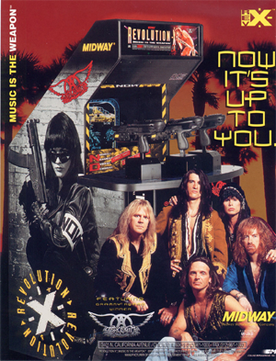
Revolution X is a shooting gallery video game developed by Midway and released in arcades in 1994. The gameplay is similar to Midway's earlier Terminator 2: Judgment Day, but is themed around the band Aerosmith. The oppressive New Order Nation regime and their leader Helga have abducted Aerosmith, and players use a mounted gun to control onscreen crosshairs and shoot enemies. The members of Aerosmith are hidden throughout the game's international locales and must be found in order to receive the game's true ending.

Street Racer is a racing video game published by Ubi Soft for various systems. It was released for the Super Nintendo Entertainment System in 1994, Sega Mega Drive in 1995, PlayStation, Sega Saturn and Game Boy in 1996 and PC and Amiga in 1997. Marketed as a "cross between Mario Kart and Street Fighter", the go-kart themed game combined racing with comedy and beat 'em up influenced violence. The game was a success on the SNES and Mega Drive and received mixed reviews across platforms.

Corpse Killer is a horror-themed rail shooter developed and published by Digital Pictures for the Sega CD, Sega CD 32X, 3DO, Sega Saturn, Windows 95 and Macintosh computers. An interactive variation on the zombie film genre, it utilizes live-action full motion video in a format similar to other games developed by Digital Pictures. Reviews for the game were mixed, generally criticizing the repetitive gameplay and low video quality, though many reviewers enjoyed the campy nature of the cutscenes. Corpse Killer was the first CD game released for the Sega 32X. It was later remastered for Steam, PlayStation 4 and Nintendo Switch.
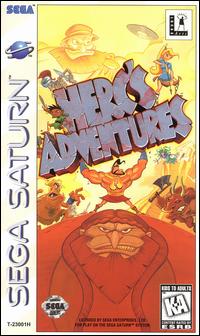
Herc's Adventures is a video game released for the Sega Saturn and PlayStation by LucasArts in 1997. The overhead, action-adventure format is similar to Zombies Ate My Neighbors. Up to two players each take on the role of one of three ancient Greek heroes: Herc (Hercules), Atlanta (Atalanta), or Jason, who are on a quest to defeat Hades and save the goddess of nature, Persephone. In 2014, it was released for PSN in North America.
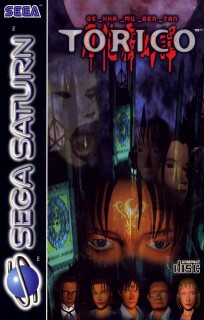
Lunacy, released in Europe as Torico and in Japan as Gekka Mugentan Torico, is an adventure game developed by System Sacom and published by Sega for the Sega Saturn in 1996. Lunacy is an interactive movie adventure consisting of a long series of interconnecting full motion video (FMV) sequences. The game is about a man named Fred who wanders around the City of Mists trying to uncover his forgotten identity. His forehead bears the imprint of a strange symbol, which seems to be the source of his amnesia. He travels to a city, where he encounters strange events and a man named Lord Gordon who rules the town with an iron fist and plays cruel games with the town's inhabitants.

Bug! is a platform game developed by Realtime Associates and published by Sega for the Sega Saturn. It was first released in North America, in 1995, weeks after the Saturn's launch there; in Europe on September 15, 1995; and, in Japan, on December 8 the same year. It was also ported to Windows 3.1x and Windows 95 in 1996 by Beam Software. The game is one of the earliest examples of 3D platforming, as well as one of the first platform games released on the Saturn. Character movement is restricted to a track, unlike many in the genre that allow for unrestricted movement in all directions.

Viewpoint is an isometric-scrolling shooter arcade game developed by Aicom and originally released in 1992 by Sammy and SNK for the Neo Geo hardware family. It was met with a highly positive critical response upon release for its cutting-edge visuals and hip hop-influenced soundtrack, though later ports for the Sega Genesis and Sony PlayStation saw much more mixed reviews.

Waterworld is a series of video games released for the Super Nintendo Entertainment System, Virtual Boy, MS-DOS, Microsoft Windows and Game Boy, based on the film of the same name, along with unpublished versions for the Mega Drive/Genesis, Sega Saturn, Atari Jaguar, 3DO and PlayStation. These games were produced by Ocean Software. The SNES and Game Boy games were released only in Europe in 1995 and the Virtual Boy game was released exclusively in North America in November 1995. It was released for PC in 1997. The game received widespread negative reviews and the version released for the Virtual Boy is generally considered to be the worst game of its 22 releases.

NHL 97 is an ice hockey video game by EA Sports. It was released in 1996 and was the successor to NHL 96. It is the sixth installment of the NHL series and the first to be released on both PlayStation and Saturn. A Panasonic M2 version was in development and slated to be one of the launch titles for it, but never happened due to the cancellation of the system.
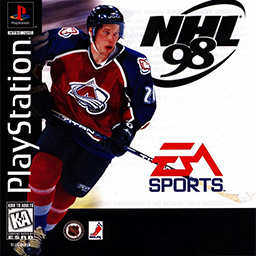
NHL 98 is an ice hockey video game developed by EA Canada. It was released in 1997 and was the successor to NHL 97. It was the last installment of the NHL series to be released on the SNES, Sega Genesis, or Sega Saturn.
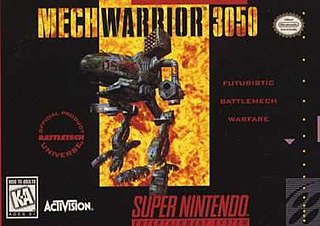
MechWarrior 3050, also known as BattleTech in its original Sega Genesis release and in Japan as BattleTech 3050 (バトルテック3050), is a 1994 mech-based video game developed by Malibu. The first BattleTech based game to be released for the Sega Genesis, it was later ported to the Super Nintendo by Activision as MechWarrior 3050. The Super Nintendo game was localized and published in Japan by Ask Group.

Madden NFL 97 is a football video game released in 1996. It was the first multiplatform Madden game released for the 32-bit consoles, being released on both the PlayStation and Sega Saturn. 16-bit versions were also made for the established Super NES and Genesis platforms, as well as a portable version for the Game Boy.

Alien Trilogy is a first-person shooter video game developed by Probe Entertainment and published by Acclaim Entertainment in 1996 for the PlayStation, Sega Saturn, and MS-DOS platforms. The game is based on the first three movies in the Alien film series. One of the first games developed by Probe following their acquisition by Acclaim, it debuted Acclaim's much-hyped motion capture technology. The game was well-received by critics, who praised its recreation of the films' atmosphere and its gameplay depth compared to other first-person shooters, and was a commercial success.

Gex is a platform game developed by Crystal Dynamics. It was originally released for the 3DO in 1995; ports of the game for the PlayStation and Sega Saturn were later developed by Beam Software, and a Windows version was released by Microsoft. It was a pack-in game for Panasonic models of the 3DO later in the console's life. It is the first in the Gex series of video games, and introduces players to the title character, a wisecracking, television-obsessed gecko voiced by comedian Dana Gould, who must venture through the "Media Dimension" and defeat Rez, the overlord of the dimension who wants to make Gex into his new network mascot.

Krazy Ivan is a mecha first-person shooter video game developed and published by Psygnosis. It was released for Windows, Sega Saturn and PlayStation in 1996.
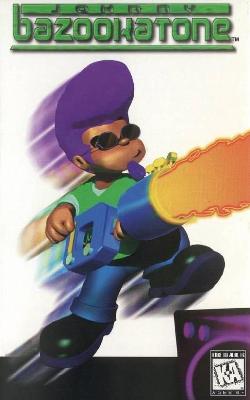
Johnny Bazookatone is a platforming video game developed by Arc Developments and published by U.S. Gold for the 3DO, PlayStation, Sega Saturn, and MS-DOS computers in 1996. Some releases also came equipped with a music CD based on the game's musical score. The game follows the protagonist, Johnny Bazookatone, trapped in the year 2050 in Sin Sin Prison by El Diablo, lord of the underworld. His guitar, known as "Anita" is taken from him, and so Johnny must travel to reclaim it.

FIFA Soccer 96 is a football simulation video game developed by Extended Play Productions and released by Electronic Arts in 1995. It was released for the Mega Drive/Genesis, Sega Saturn, Sega 32X, Game Gear, PlayStation, Super Nintendo Entertainment System, and MS-DOS compatible operating systems.

Whizz is a 1994 isometric platform game released for the Amiga, Amiga CD32, and DOS. In 1996, it was ported to the Super NES and in 1997 to the PlayStation and Sega Saturn. A Sega Mega Drive version was planned but never released. Within the game, "Whizz" refers to the player character's magical talents, being short for "wizard". Marketing for the game used it in reference to the slang term for urination, such as in the advertising slogan "Ever feel the need for a Whizz real bad? You will."
